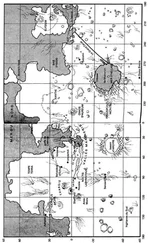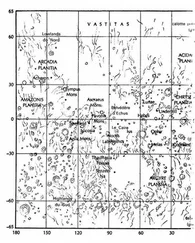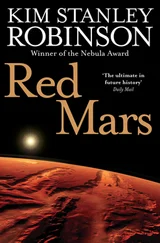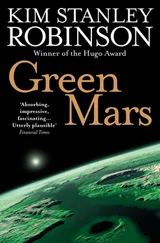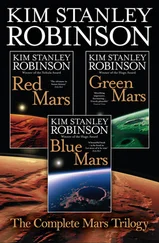When they had descended to the lowlands of the northern hemisphere, they turned and drove straight north across the immense Acidalia Planitia, and again ran straight for several days. Their wheel tracks stretched behind them like the first cut of a lawnmower through grass, and the transponders gleamed bright and incongruous among the rocks. Phyllis, Edvard and George talked about making a few side trips, to investigate some indications seen in satellite photos that there were unusual mineral outcroppings near Perepelkin Crater. Ann reminded them irritably of their mission. It made Nadia sad to see that Ann was nearly as distant and tense out here as she was back at base; whenever the rovers were stopped she was outside walking around alone, and she was withdrawn when they sat together in Rover One to eat dinner. Occasionally Nadia tried to draw her out: “Ann, how did all these rocks get scattered around like this?”
“Meteors.”
“But where are the craters?”
“Most are in the south.”
“But how did the rocks get here, then?”
“They flew. That’s why they’re so small. It’s only smaller rocks could be tossed so far.”
“But I thought you told me that these northern plains were relatively new, while the heavy cratering was relatively old.”
“That’s right. The rocks you see here come from late meteor action. The total accumulation of loose rock from meteor strikes is much greater than what we can see, that’s what gardened regolith is. And the regolith is a kilometer deep.”
“It’s hard to believe,” Nadia said. “I mean, that’s so many meteors.”
Ann nodded. “It’s billions of years. That’s the difference between here and Earth, the age of the land goes from millions of years to billions. It’s such a big difference it’s hard to imagine. But seeing stuff like this can help.”
Midway across Acidalia they began running into long, straight, steep-walled, flat-bottomed canyons. They looked, as George noted more than once, like the dry beds of the legendary canals. The geological name for them was fossae , and they came in clusters. Even the smallest of these canyons were impassable to rovers, and when they came on one they had to turn and run along its rim, until its floors rose or its walls drew together, and they could continue north over the flat plain again.
The horizon ahead was sometimes twenty kilometers off, sometimes three. Craters became rare, and the ones they passed were surrounded by low mounds that rayed out from the rims— splosh craters, where meteors had landed in permafrost that had turned to hot mud in the impact. Nadia’s companions spent a day wandering eagerly over the splayed hills around one of these craters. The rounded slopes, Phyllis said, indicated ancient water as clearly as the grain in petrified wood indicated the original tree. By the way she spoke Nadia understood that this was another of her disagreements with Ann; Phyllis believed in the long wet past model, Ann in the short wet past. Or something like that. Science was many things, Nadia thought, including a weapon with which to hit other scientists.
Farther north, around latitude 54°, they drove into the weird-looking land of thermokarsts, hummocky terrain spotted by a great number of steep-sided oval pits, called alases . These alases were a hundred times bigger than their Terran analogues, most of them two or three kilometers across, and about sixty meters deep. A sure sign of permafrost, the geologists all agreed; seasonal freezing and thawing of the soil caused it to slump in this pattern. Pits this big indicated that water content in the soil must have been high, Phyllis said. Unless it was yet another manifestation of Martian time scales, Ann replied. Slightly icy soil, slumping ever so slightly, for eons.
Irritably Phyllis suggested that they try collecting water from the ground, and irritably Ann agreed. They found a smooth slope between depressions, and stopped to install a permafrost water collector. Nadia took charge of the operation with a feeling of relief; the trip’s lack of work had begun to get to her. It was a good day’s job: she dug a ten-meter long trench with the lead rover’s little backhoe; laid the lateral collector gallery, a perforated stainless steel pipe filled with gravel; checked the electric heating elements running in strips along the pipe and filters; then filled in the trench with the clay and rocks they had dug out earlier.
Over the lower end of the gallery was a sump and pump, and an insulated transport line leading to a small holding tank. Batteries would power the heating elements, and solar panels charge the batteries. When the holding tank was full, if there was enough water to fill it, the pump would shut off and a solenoid valve would open, allowing the water in the transport line to drain back into the gallery, after which the heating elements would shut off as well.
“Almost done,” Nadia declared late in the day, as she started to bolt the transport pipe onto the last magnesium post. Her hands were dangerously cold, and her maimed hand throbbed. “Maybe someone could start dinner,” she said. “I’m almost done here.” The transport pipe had to be packed in a thick cylinder of white polyurethane foam, then fitted into a larger protective pipe. Amazing how insulation complicated a simple piece of plumbing.
Hex nut, washer, cotter pin, a firm tug on the wrench. Nadia walked along the line, checking the coupling bands at the joints. Everything firm. She lugged her tools over to Rover One, looked back at the result of the day’s work: a tank, a short pipe on posts, a box on the ground, a long low mound of disturbed soil running uphill, looking raw but otherwise not unusual in this land of lumps. “We’ll drink some fresh water on our way back,” she said.
• • •
They had driven north for over two thousand kilometers, and finally rolled down onto Vastitas Borealis, an ancient cratered lava plain that ringed the northern hemisphere between latitudes 60° and 70°. Ann and the other geologists spent a couple of hours every morning out on the bare dark rock of this plain, taking samples, after which they would drive north for the rest of the day, discussing what they had found. Ann seemed more absorbed in the work, happier. One evening Simon pointed out that Phobos was running just over the low hills to the south; the next day’s drive would put it under the horizon. It was a remarkable demonstration of just how low the little moon’s orbit was— they were only at latitude 69°! But Phobos was only some 5,000 kilometers above the planet’s equator. Nadia waved good-bye to it with a smile, knowing she would still be able to talk to Arkady using the newly arrived areosynchronous radio satellites.
Three days later the bare rock ended, running under waves of blackish sand. It was just like coming on the shore of a sea. They had reached the great northern dunes, which wrapped the world in a band between Vastitas and the polar cap; where they were going to cross, the band was about 800 kilometers wide. The sand was a charcoal color, tinged with purple and rose, a rich relief to the eye after all the red rubble of the south. The dunes trended north and south, in parallel crests that occasionally broke or merged. Driving over them was easy; the sand was hard-packed, and they only had to pick a big dune and run along its humpbacked western side.
After a few days of this, however, the dunes got bigger, and became what Ann called barchan dunes. These looked like huge frozen waves, with faces a hundred meters tall, and backs a kilometer wide, and the crescent that each wave made was several kilometers long. As with so many other Martian landscape features, they were a hundred times larger than their Terran analogues in the Sahara and Gobi. The expedition kept a level course over the backs of these great waves by contouring from one wave back to the next, their rovers like tiny boats, paddle-wheeling over a black sea that had frozen at the height of a titanic storm.
Читать дальше
Конец ознакомительного отрывка
Купить книгу





